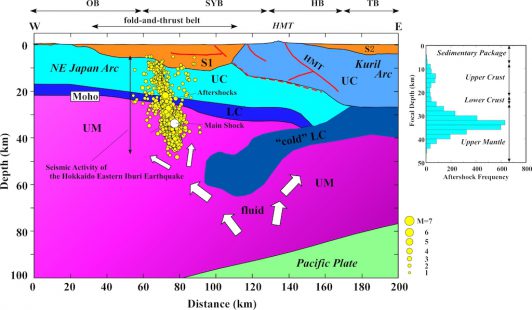- Recommended articles
- November 4, 2019
[Frontier Letter] Structural heterogeneity in and around the fold-and-thrust belt of the Hidaka Collision zone, Hokkaido, Japan and its relationship to the aftershock activity of the 2018 Hokkaido Eastern Iburi Earthquake

The 2018 Hokkaido Eastern Iburi Earthquake (M=6.7) occurred at a very deep depth (~37 km) beneath the foreland fold-and-thrust belt of the Hidaka Collision Zone, Hokkaido, Japan. From the previously acquired controlled source seismic data, Iwasaki et al. (2019) revealed the detailed structure beneath this fold-and-thrust belt and its relationship with the aftershock activity of this earthquake. Relocated aftershocks are at depths of 7-45 km with steep geometry, extending to the uppermost mantle of the eastward descending NE Japan arc. High aftershock activity in the mantle indicates that the cold crust delaminated from the Kuril Arc side by the arc-arc collision prevents the thermal circulation and cools the mantle to generate favorable conditions for brittle fracture. View articles:
- Iwasaki et al. (2019): Structural heterogeneity in and around the fold-and-thrust belt of the Hidaka Collision zone, Hokkaido, Japan and its relationship to the aftershock activity of the 2018 Hokkaido Eastern Iburi Earthquake. Earth Planets Space, 71:103, doi:10.1186/s40623-019-1081-z.
- Special Issue: The 2018 Hokkaido Eastern Iburi Earthquake and Hidaka arc-arc collision system
- Collection: Frontier Letters

![[Frontier Letter] COURSE: Cross-scale cOUpling pRocesses in the Solar–tErrestrial system—SCOSTEP’s new program for 2026–2030](https://www.earth-planets-space.org/wp-content/uploads/2025/12/fig1-80x26.png)
![[Frontier Letter] Double difference earthquake location with graph neural networks](https://www.earth-planets-space.org/wp-content/uploads/2025/08/40623_2025_2251_Figa_HTML-1-80x40.webp)
![[Frontier Letter] A new paleomagnetic constraint on the duration of a twin caldera-forming eruption sequence: a potential solution to an enduring problem in decoding >VEI 7 eruption timescales](https://www.earth-planets-space.org/wp-content/uploads/2025/05/40623_2025_2179_Figa_HTML-75x40.webp)

